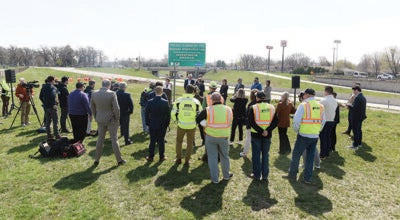State outlines education challenges as number of confirmed cases climbs
Published 7:28 am Saturday, April 25, 2020
|
Getting your Trinity Audio player ready...
|
Gov. Tim Walz brought in the voices of teachers and students along with state health officials Friday as he updated Minnesota on the efforts to deal with the educational, medical and economic fallout from COVID-19.
The governor’s afternoon briefing with reporters typically focuses on the latest efforts of various state agencies. On Friday, that included news about a a new website offering citizens information on where to get tested.
Much of the Friday briefing, though, focused on the challenges of teaching and learning with school buildings shuttered. The governor and Lt. Gov. Peggy Flanagan acknowledged that some kids are struggling with distance learning and that many of those struggles fall along racial, ethnic and income lines.
The pandemic has “laid bare” the inequities in Minnesota’s education system, Flanagan said.
Her comments came as the COVID-19 death toll climbed to 221 Friday, up 21 from Thursday, while the number of total confirmed cases topped 3,000 for the first time. Current hospitalizations and intensive care cases also rose.
Death and case counts have been sharply higher all week and are expected to continue surging. The latest numbers come a day after Walz relaxed some business restrictions but kept school buildings closed and raised doubts about the Minnesota State Fair opening in August.
Deadline looms on stay-home order
Walz is still evaluating how long to keep Minnesota’s stay-at-home order in place. The current restrictions on nonessential travel and activities are in place until May 4.
The DFL governor has been gradually allowing more exceptions. Up to 100,000 employees will be able to head back to factories or office buildings on Monday. But Walz said expansions in the capacity to test, trace and isolate around COVID-19 will determine how fast other elements of society can reopen.
“Opening up recklessly will only make things worse. Opening up without a plan will make things worse,” Walz said on a call Friday morning with mayors and other local officials. “But hunkering down and doing nothing will cause that pain, as I talked about yesterday, that makes it impossible to move forward.”
Other states are further along in resuming retail activities but Walz said he won’t put public health at risk to speed a reopening.
While Walz did offer some optimism Thursday, including the relaxed business guidance, he also signaled that Minnesota was still not close to allowing the return of people in packed public spaces, including crowded bars, restaurants or major sporting events and warned of a coming surge in COVID-19 cases as testing ramps up dramatically.
Walz said on Friday that the supply chain of personal protective equipment has opened up somewhat and having enough PPE and space is a big part in decision making on whether or not to reopen elective surgeries, which would also need space and PPE supplies.
School closings exposing gaps
While 100,000 Minnesotans could get back to work next week, public school buildings will remain closed for the remainder of this school year — a decision that Walz and Lt. Gov. Peggy Flanagan on Friday described as incredibly difficult.
He and Flanagan also acknowledged that many Minnesotans do not have the broadband access and other technical means to make distance learning work.
Minnesota Education Commissioner Mary Cathryn Ricker said officials were working now on ways to improve broadband access and get updated technology into the hands of students who need it, and hoped to tap federal COVID-19 aid funding to pay for it.
Friday’s briefing call with the governor and state leaders also included students and teachers who’ve been struggling to deal with the loss of face-to-face classroom contact.
A Twin Cities math teacher on the call said the COVID-19 crisis has brought racial and ethnic disparities in education into a harsh spotlight. Many of her students, she said, are unable to stay in touch or do homework; others have become full-time caregivers for their families, she added.
Claire Murphy, a 10-year-old St. Paul student on the call with state leaders and reporters, said she didn’t get to say goodbye to teachers and friends before the school year ended, which makes her sad, and that she doesn’t like distance learning as much as going to school.
“I know there are a lot of tears shed over this” among students and families, Walz said.
New website to find COVID-19 testing
As part of the governor’s new plan to team up with Mayo Clinic and the University of Minnesota and launch a massive new testing effort in Minnesota, Walz’s office on Friday unveiled a new website offering citizens information on and where to get tested and how to obtain the results.
Testing in Minnesota and elsewhere has been hampered by supply chain issues and materials shortages. Minnesota has tested about 1,200 or so people daily as of late. That’s only about one-quarter of the testing Walz says is needed.
For weeks, Walz has said that drastically increased testing would be critical to restarting parts of the economy. Two kinds of tests, ones that diagnose COVID-19 and others that see if a person has been exposed to the virus, are included in the plan, along with increased tracing.
While the plan to test 20,000 people a day would make Minnesota No. 1 in the nation for testing, Walz said testing alone would not end the crisis.
Younger and older deaths
Death and case counts are expected to continue their upward climb. Friday marked four consecutive days recording double-digit deaths.
The age range of deaths from the disease has also widened — the oldest victim is now listed at 109 years old, the youngest, 50. A 4-week-old Minnesotan remains hospitalized.
Among those those who’ve died from COVID-19, officials say most were living in long-term facilities and had underlying health problems.
Among cases in long-term care, 820 involved residents, while 303 involved health care workers. cases. A total of 172 long-term care facilities in Minnesota have at least one confirmed COVID-19 case, said state infectious disease director Kris Ehresmann.
Health Commissioner Jan Malcolm said the state is trying to help those facilities fill staffing gaps when too many workers are out.
Among other statistics, the Health Department reported:
- 278 people remain hospitalized, up 10 from Thursday.
- 111 are in intensive care, up 7 from the prior day.
- 3,185 people have tested positive for the virus across Minnesota since the pandemic began, with half of those patients recovered to the point they no longer need isolation.
Officials say the number of positive tests is only a sliver of the number of people carrying the coronavirus, which causes COVID-19.





